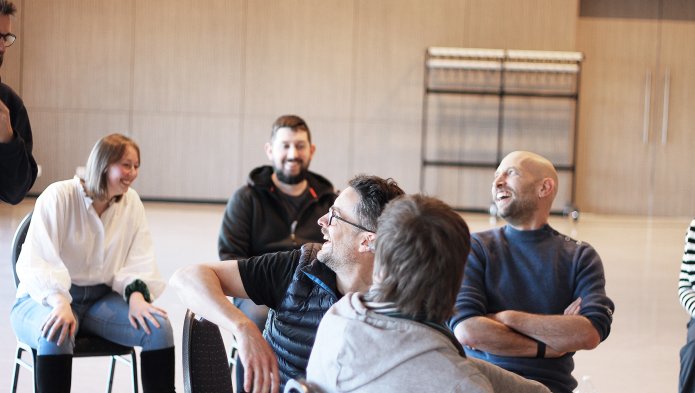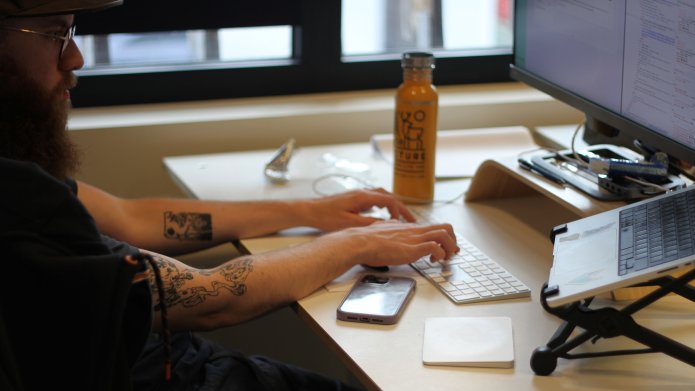The transition from school to professional life is a crucial moment for a designer. From the pressure of deadlines to collaborating with other departments, managing stress, and embracing new processes, working in an agency changes the way you design.
At WebstanZ, every new colleague is coached throughout this transition so that they can grow in a challenging but exciting environment. Here is a concrete overview of what changed for me when I made the transition from school to the reality of a web agency.
The stress of agency life
There is pressure: deadlines, customer feedback, technical restrictions... But it all starts with putting things into perspective. When I joined WebstanZ, a colleague said something to me that still resonates with me today:
'We don't save lives, we build websites'
This sentence does not minimize my job: it simply reminds us that stress can be a driving force rather than a burden. In my position, as a UX/UI designer, this constructive, positive stress, known as eustress, stimulates creativity, improves concentration, and pushes us to excel.
However, organization remains essential: planning, prioritizing, structuring your work, and using the right tools prevents overload and allows you to maintain a clear vision of each project.
Adapt to internal processes
At school, there is complete creative freedom. In an agency, I had to learn to work in collaboration with other specialists. Back-end developers, front-end developers, project managers... each person works independently and at different stages of the project. You also have to be able to manage these interactions.

Based on my experience, I would say that joining an agency means above all understanding:
- how the internal workflow works,
- collaborative tools,
- project methodologies (scrum, design system, documentation, etc.),
- the role and limitations of each field.
In addition, each agency has its own culture, values, and vision. Familiarizing yourself with this environment (its codes, pace, and organization) is essential for fast development. To do this, questions, curiosity, and a desire to learn will be your best allies.
Communication: the key skill
The quality of a project often also relies on the quality of communication between the teams involved. Sharing ideas, explaining choices, documenting decisions, and keeping everyone in the loop on progress are all key to keeping things running smoothly and customer happy.
In general, my work as a designer takes place at the beginning of a project, but it is not limited to simple visual creation. I am responsible for preparing the field and handing over to the developers to ensure a smooth and faithful implementation of our designs.
This involves providing them with:
- precise and detailed specifications
- sometimes interactive prototypes
- a well-organized design system

Project managers often serve as the link between teams and clients, but sometimes I have direct contact with clients myself. This allows me to ask them specific questions, clarify certain unclear issues, or get precise, real-time feedback. It also gives me the chance to show them my expertise and professionalism, which is really satisfying.
My tips for success in an agency
Measuring time
Measuring your time is a simple but essential reflex in an agency. At school, the concept of planning often remains theoretical. In professional life, it directly influences the organization of projects and the work of the entire team. Tracking the time spent on each task allows you to better understand your own pace, anticipate busier periods, and avoid unexpected events.
It's also the best way to improve your forecasts: by regularly comparing what was planned with the time actually spent, discrepancies are reduced and forecasts become more reliable—an essential skill in an agency where deadlines matter.
Keep up with the latest developments to stay inspired
Staying up to date is an integral part of a designer's job. Trends evolve, tools change, new methodologies emerge... Staying informed fuels creativity and enhances the quality of proposals.
Specialized blogs, newsletters, social networks, inspiration platforms... Everyone can develop a routine that suits their way of working. The important thing is to remain curious and consult these sources regularly to fuel your ideas and maintain high standards.

Use to-do lists to organize your work
In agencies, designers often have several projects running at once. Without organization, it's easy to get lost. To-do lists help you keep a clear view of the tasks ahead and avoid mental overload.
They help you prioritize, move forward step by step, and maintain a sense of control, even when schedules accelerate. It's a simple but incredibly effective tool for working calmly in a dynamic environment.
Conclusion
Transitioning from school to a digital agency is an intense and formative experience. With good stress management, open communication, solid organization, and a willingness to learn continuously, every young designer can thrive in their new role.
At WebstanZ, we create an environment that values collaboration, transparency, and continuous improvement. These foundations allow designers to express their talent, grow professionally, and contribute to ambitious and useful digital projects.



